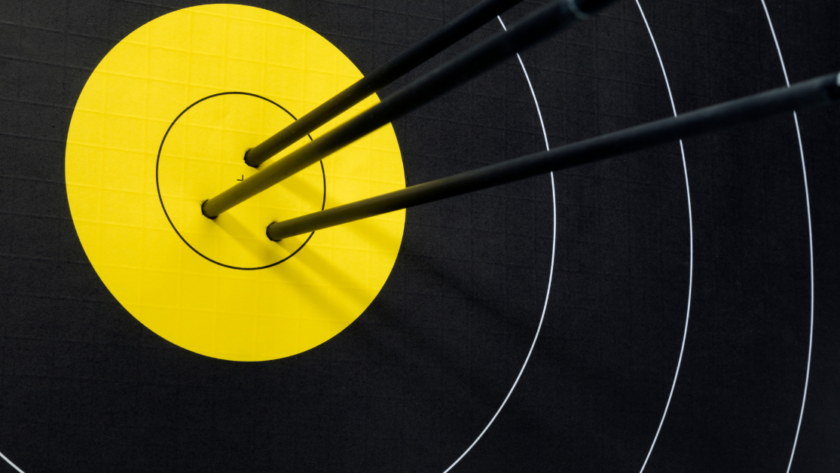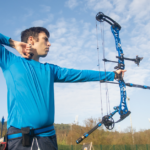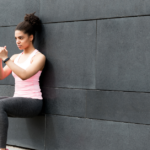As an experienced archer and instructor, I’ve seen countless students struggle with their aim. The good news?
With the right techniques and consistent practice, anyone can dramatically improve their accuracy.
This guide will walk you through everything you need to know to take your archery skills to the next level.
The Foundation: Proper Form
Anchor Point: Your Accuracy Compass
Your anchor point serves as the consistent position where your drawing hand meets your face. It’s crucial for maintaining shot-to-shot consistency.
Here’s how to find and perfect your anchor point:
- Experiment with different positions: Try anchoring under your chin, at the side of your jaw, or at the corner of your mouth.
Each archer’s ideal anchor point is unique.
- Consistency is key: Once you’ve found a comfortable position, practice it relentlessly.
Close your eyes, draw to anchor, then open them.
If you’re consistently in the right spot, you’re on track.
- Use tactile references: Feel for specific points on your face, like your jawbone or the corner of your mouth, to confirm you’re anchoring in the same spot every time.
- Consider additional aids: Some archers find kisser buttons or nose buttons helpful for maintaining a consistent anchor.
Body Alignment: The Archer’s Skeleton Key
Proper alignment confirms effective energy transfer from your body to the arrow. Here’s how to achieve optimal alignment:
- Stance: Stand perpendicular to the target with your feet shoulder-width apart.
Your weight should be evenly distributed.
- Bow arm: Your bow arm should form a straight line from your shoulder through your elbow to the bow.
Avoid locking your elbow, as this can lead to string slap.
- Drawing arm: At full draw, your drawing arm should create a “T” shape with your torso.
Your elbow should be slightly higher than your arrow.
- Torso: Keep your upper body straight and perpendicular to the ground.
Avoid leaning back or forward.
- Head position: Your head should be upright and turned towards the target.
Avoid tilting or canting your head.
The Release: Letting Go with Purpose
A clean release is essential for accurate shooting. Here’s how to perfect your release:
- Back tension: Focus on squeezing your shoulder blades together as opposed to consciously releasing with your fingers.
This promotes a smoother, more consistent release.
- Finger placement: For finger shooters, use the first joint of your index, middle, and ring fingers to draw the string.
Keep your fingers relaxed to avoid plucking the string.
- Follow-through: After release, your drawing hand should naturally move back along your jaw or neck.
Resist the urge to drop your arm immediately.
- Mechanical releases: If you’re using a mechanical release aid, practice activating it smoothly and consistently.
Avoid punching or slapping the trigger.
Mental Mastery: The Archer’s Secret Weapon
While physical technique is crucial, the mental aspect of archery is equally important. Here’s how to harness the power of your mind:
Visualization: Seeing Success Before It Happens
Visualization is a powerful tool for improving performance. Here’s how to incorporate it into your practice:
- Pre-shot routine: Before each shot, take a moment to visualize the entire process.
See yourself drawing the bow, feeling the anchor point, and watching the arrow fly true to the target.
- Positive imagery: Focus on successful shots and positive outcomes.
Avoid dwelling on past mistakes or potential failures.
- Sensory details: Include as many sensory details as possible in your visualization.
Feel the tension in the bow, hear the sound of the release, and see the arrow hitting the bullseye.
- Regular practice: Spend time visualizing outside of your regular shooting sessions.
This mental rehearsal can be just as valuable as physical practice.
Focus and Breathing: Calm in the Storm
Controlling your breathing and maintaining focus are essential for consistent accuracy. Here’s how to develop these skills:
- Breathing technique: Inhale deeply as you draw, then exhale halfway and hold as you aim and release.
This helps reduce body movement and calms your mind.
- Mindfulness: Practice being present in the moment.
Focus on the sensations of drawing the bow and the sight picture, as opposed to getting caught up in thoughts about the outcome.
- Concentration drills: Practice focusing on a single point for extended periods.
Start with short durations and gradually increase the time.
- Dealing with distractions: Learn to thank distractions without letting them affect your shot.
Practice shooting in various conditions to build resilience.
Equipment Optimization: Fine-Tuning Your Tools
Even the best technique can be undermined by poorly tuned equipment. Here’s how to confirm your gear is working for you:
Bow Tuning: Harmony in Motion
A well-tuned bow is essential for accuracy. Here’s how to get your bow in top shape:
- Paper tuning: Start by shooting through paper to check arrow flight.
Adjust your rest and nocking point until you achieve clean, straight tears.
- Walk-back tuning: Fine-tune your sight by shooting at various distances.
This helps confirm your sight is properly aligned with your arrow’s trajectory.
- Cam timing: For compound bows, check that your cams are synchronized. This confirms smooth and consistent draw and release.
- Limb balance: For recurve bows, confirm that your limbs are balanced and aligned properly.
- String and cable maintenance: Regularly check for wear and replace when necessary.
Wax your string to keep it in good condition.
Arrow Selection: The Right Shaft for the Job
Choosing the fix arrows is crucial for accuracy. Here’s what to consider:
- Spine: Select arrows with the suitable spine (stiffness) for your draw weight and length.
Arrows that are too stiff or too weak will fly erratically.
- Weight: Consider the total weight of your arrows, including points.
Heavier arrows are more stable but slower, while lighter arrows are faster but more affected by wind.
- Length: Your arrows should be long enough to safely clear your bow’s riser but not so long that they affect spine dynamics.
- Fletching: Experiment with different fletching sizes and configurations to find what works best for your setup and shooting style.
- Point weight: Adjusting point weight can fine-tune arrow flight and affect how your arrows group at different distances.
Advanced Aiming Techniques
Once you’ve mastered the basics, consider exploring these advanced aiming methods:
Gap Shooting: Bridging the Distance
Gap shooting involves using the tip of your arrow as a reference point. Here’s how to develop this skill:
- Establish a point-on distance: Find the distance at which your arrow tip aligns with your target when aiming directly at it.
- Learn your gaps: At closer distances, you’ll need to aim below the target.
At farther distances, you’ll aim above.
Practice to learn these gaps for various distances.
- Use reference points: Utilize features on your bow or in your sight picture to help gauge distances and gaps.
- Practice at various distances: Regularly shoot at different ranges to internalize the feel of different gaps.
String Walking: Precision Through Positioning
String walking is popular in barebow archery and allows for precise aiming without sights. Here’s how it works:
- Adjust finger position: Place your fingers at different positions on the string based on distance.
Lower positions are for closer targets, higher positions for farther targets.
- Use a tab with markings: Many string walkers use tabs with measured markings to confirm consistent finger placement.
- Combine with face walking: Some archers also adjust their anchor point in conjunction with string walking for even more precise aiming.
- Practice and record: Keep detailed notes on your finger positions for various distances to build a consistent system.
Instinctive Shooting: Becoming One with the Bow
Instinctive shooting relies on developing an intuitive feel for where the arrow will go. Here’s how to cultivate this skill:
- Focus on the target: Train yourself to focus intensely on the exact spot you want to hit, as opposed to on your arrow or bow.
- Start close: Begin practicing at very close ranges and gradually increase distance as your accuracy improves.
- Shoot volume: Instinctive shooting requires extensive practice to develop the necessary muscle memory and intuition.
- Vary your practice: Shoot at different targets, distances, and angles to build a well-rounded instinctive shooting ability.
Common Pitfalls and How to Avoid Them
Target Panic: The Archer’s Nemesis
Target panic is a psychological condition that can cause archers to release prematurely or freeze up when aiming. Here’s how to overcome it:
- Focus on process: Shift your attention from the outcome to the process of shooting.
Develop a consistent shot sequence and focus on executing each step.
- Blank bale shooting: Practice shooting at a blank target at close range.
This helps rebuild confidence and reinforces proper form without the pressure of aiming.
- Use a back tension release: For compound archers, a back tension release can help retrain your shot process by removing the conscious trigger activation.
- Mental training: Work on visualization and relaxation techniques to manage anxiety and build confidence.
- Seek professional help: Consider working with a sports psychologist or experienced coach who specializes in target panic.
Inconsistent Anchor: The Wandering Reference Point
An inconsistent anchor point can wreak havoc on your accuracy. Here’s how to combat this issue:
- Develop tactile references: Use specific points on your face as consistent reference points for your anchor.
- Practice blind drawing: Close your eyes and draw to anchor, then open them to check your position.
This builds muscle memory and consistency.
- Use aids: Consider using a kisser button or nose button for additional consistency in your anchor point.
- Video analysis: Record yourself shooting and analyze your anchor point frame by frame to identify inconsistencies.
- Focus on feeling: Pay attention to how a proper anchor feels, not just how it looks.
This internal feedback can help you maintain consistency.
Adapting Your Technique
Every archer is unique, and what works for you may not work for another. Here’s how to adapt these techniques to your person needs:
- Experiment: Try different anchor points, release methods, and aiming techniques to find what feels most natural and effective for you.
- Consider physical limitations: Adjust your stance and form based on your body type, flexibility, and any physical limitations you may have.
- Be open to change: As you progress, be willing to refine and adjust your technique.
What works for you as a beginner may not be optimal as you advance.
- Seek feedback: Work with coaches or experienced archers who can provide goal feedback on your form and technique.
- Keep a journal: Record your practice sessions, noting what works well and what doesn’t.
This can help you identify patterns and make informed adjustments.
Building on the Basics: The Path to Mastery
As you incorporate advanced techniques, don’t neglect the fundamentals. Regular practice of basic form drills will reinforce good habits and provide a solid foundation for more complex skills.
Exercises to Elevate Your Aim
- Blank bale shooting: Practice your form without the pressure of hitting a target.
Focus on feeling each element of your shot process.
- Single spot focus: Shoot at a single spot on a blank target to improve concentration and mental discipline.
- Distance variation: Practice at various distances to develop a feel for trajectory and improve your distance estimation skills.
- Pressure drills: Simulate competition scenarios to build mental toughness and learn to perform under pressure.
- Form checks: Regularly video yourself shooting and analyze your form to catch and fix any developing bad habits.
- Group analysis: Pay attention to your arrow groupings.
They can provide valuable feedback on consistency and any form issues.
- Strength training: Incorporate exercises to build the specific muscles used in archery, improving your stamina and stability.
People Also Asked
What is the best anchor point for archery?
The best anchor point varies by person and shooting style. Common anchor points include the corner of the mouth, under the chin, or along the jawline.
Experiment to find what’s most comfortable and consistent for you.
How can I improve my archery accuracy quickly?
Focus on developing consistent form, particularly your anchor point and release. Practice regularly, even if only for short sessions.
Consider working with a coach to identify and fix any form issues.
What causes target panic in archery?
Target panic often stems from performance anxiety or an overemphasis on results. It can be triggered by a fear of missing, past negative experiences, or excessive pressure to perform well.
How often should I practice archery to improve?
Consistent practice is key. Aim for at least 3-4 sessions per week, even if they’re short.
Quality of practice is more important than quantity, so focus on proper form and technique during each session.
What’s the difference between instinctive and gap shooting in archery?
Instinctive shooting relies on intuition and muscle memory, with the archer focusing solely on the target. Gap shooting involves using the arrow tip as a reference point, consciously aiming above or below the target based on distance.
How do I choose the right arrows for my bow?
Consider your bow’s draw weight and length, as well as your shooting style. Arrows should be properly spined (stiffness) for your setup.
Consult with a pro shop or experienced archer to find the best match for your equipment.
Can archery be self-taught?
While it’s possible to learn the basics of archery on your own, working with a coach or experienced archer can help you develop proper form and avoid bad habits.
Self-taught archers often benefit from occasional professional instruction to refine their technique.
What muscles does archery strengthen?
Archery primarily strengthens the muscles in your shoulders, back, and arms. Key muscle groups include the deltoids, trapezius, rhomboids, and latissimus dorsi.
Core muscles are also engaged for stability.
How long does it take to become proficient in archery?
The time to proficiency varies greatly depending on natural aptitude, practice frequency, and quality of instruction.
With regular practice, many archers see significant improvement within 3-6 months, but mastery can take years of dedicated training.
What’s the difference between Olympic recurve and barebow archery?
Olympic recurve archery allows the use of sights, stabilizers, and other accessories, while barebow archery prohibits these aids.
Barebow archers typically use techniques like string walking or face walking for aiming.
Key Takeaways:
- Consistent form is the foundation of accuracy in archery
- Develop a reliable anchor point and release technique
- Mental preparation and focus are as important as physical skills
- Properly tuned equipment is essential for precision shooting
- Advanced aiming techniques can take your accuracy to new heights
- Recognize and address common pitfalls like target panic
- Adapt techniques to suit your person needs and style
- Regular, focused practice is crucial for continuous improvement



